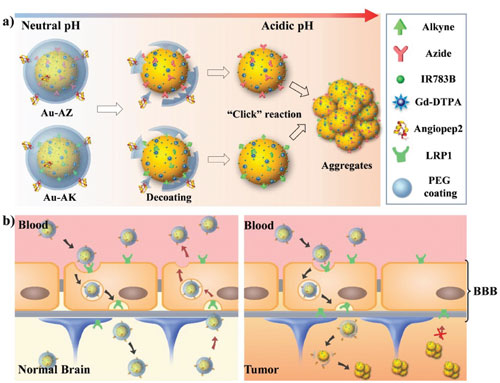| Posted: Jun 21, 2017 | |
Guiding brain tumor surgery with nanoprobes(Nanowerk News) Researchers in China have developed two pH-responsive nanoprobes to guide brain-tumor surgery via the magnetic resonance (MR) and surface-enhanced resonance Raman spectroscopy (SERRS) signals activated upon their self-assembly in acidic tumor extracellular fluid. |
|
| Reporting their findings in Advanced Materials ("Guiding Brain-Tumor Surgery via Blood–Brain-Barrier-Permeable Gold Nanoprobes with Acid-Triggered MRI/SERRS Signals"), the team demonstrated that their gold nanoparticle based nanoprobes were able to enter brain tumors by crossing the blood–brain barrier (BBB). | |
 |
|
| Guiding brain-tumor surgery by acid-responsive gold nanoprobes. a) The cleavage of the PEG coating in physiological acidity triggers aggregation between Au–AZ and Au–AK via 'click' cycloaddition reactions. b) Due to the LPR1-mediated, bidirectional, BBB-traversing strategy, while the bulky AuNS aggregates are continuously trapped in tumor acidic interstitium, the intact nanoprobes in the normal brain tissue can be transported back into the blood stream, which increases the sensitivity for the brain-tumor margins. (© Wiley-VCH Verlag) (click on image to enlarge) | |
| The novel features of the pH-responsive nanoprobes include: | |
|
|
|
| "As far as we are aware, this pair of nanoprobes is the first example of a system that guides brain-tumor resection by sensing acidic tumor microenvironments," the authors conclude. "They are promising candidates to improve the outcome of brain-tumor surgery and accelerate the clinical translation of AuNS-based imaging probes." |
 By
Michael
Berger
– Michael is author of three books by the Royal Society of Chemistry:
Nano-Society: Pushing the Boundaries of Technology,
Nanotechnology: The Future is Tiny, and
Nanoengineering: The Skills and Tools Making Technology Invisible
Copyright ©
Nanowerk LLC
By
Michael
Berger
– Michael is author of three books by the Royal Society of Chemistry:
Nano-Society: Pushing the Boundaries of Technology,
Nanotechnology: The Future is Tiny, and
Nanoengineering: The Skills and Tools Making Technology Invisible
Copyright ©
Nanowerk LLC
|
|
|
Subscribe to a free copy of one of our daily Nanowerk Newsletter Email Digests with a compilation of all of the day's news. |
